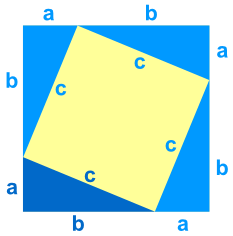I've been teaching the Pythagorean Theorem in my 8th grade class, and I noticed something odd. In the book I'm using, the sequence goes something like this:
- Motivate the idea of distances on a grid
- Talk about areas on a lattice grid
- Work on finding the areas of irregular shapes -- including tilted squares
- Talk about the relationship between squares and side lengths, introduce irrationals and things like that.
- Look at squares coming off of a triangle. By now, students can find the area of all 3 squares coming off the right triangle, and derive the equation a^2+b^2=c^2 just by observation from a few example problems.
While I think this is very cool, it's not really a proof. They see a few example cases, and then the sum of the squares coming off of the legs of the triangle are exactly the same as the area of the square off the hypotenuse! And if we introduce labels a, b, and c instead of numbers, they can derive the Pythagorean Theorem this way. I noticed that a lot of teachers teach the Pythagorean Theorem this way. There are a lot of visual gifs and videos showing that the areas of the squares coming off the triangle add up, but is that technically a proof? At this point, the students are actually very close to seeing a more algebraic proof by the time they get to that last bullet point!
All they would need to do is take the tilted square (c^2) and find the area with respect to labels a and b.
There's two ways to do this. The "inside" way and the "outside way". The inside way is adding up all the inside areas using labels a and b. The outside way is taking the outer box and subtracting off the corner triangles. Using real numbers, this isn't very difficult, but using a, b, and c as the numbers is a huge "cognitive leap" for these students. So at the end of the day, my question is: Should I be leading students through an actual proof of the Pythagorean Theorem? Or is an exploration of deriving the formula good enough?
I hope this all made sense! If not, I'll do my best to clear things up.



